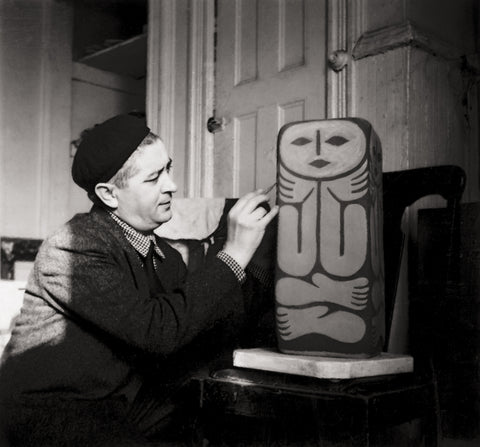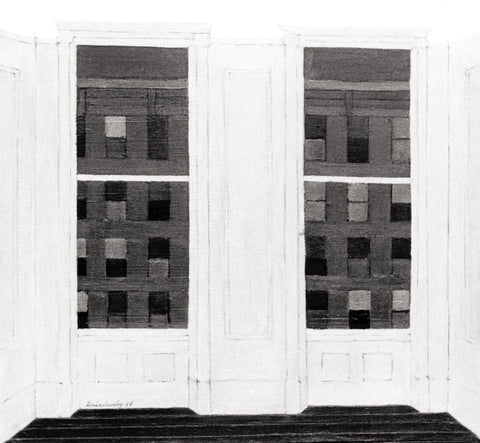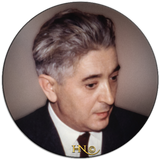Reflections of an Artist

More than thirty years ago, while still at the Academy of Fine Arts in Zagreb, I decided to create a series of tree portraits in wood. I was studying painting and sculpture, but had never studied printmaking. I was so fascinated by the project, that despite my lack of training, in 1944 I decided to start the project. To prepare for the series, I started with some small woodcuts. The first of these, my first woodcut was "Head".

I cut several other woodcuts before I felt that I was somewhat acquainted with woodcutting technique, enough to be able to start working on the tree series.

The first tree subject I cut in wood was "Bush". I also created a drawing of a pine forest, which I later translated into the woodcut "Forest". These two woodcuts were not meant to be part of the series. They were only in preparation for it.


At that time, I was strongly style-conscious. The preliminary woodcuts were only to be studies to develop a style for the tree series. Working on these early woodcuts, I ran into many difficulties and much self-doubt, I gave up not only my planned project for a portfolio of trees, but also woodcuts for several years. My doubts contaminated my painting as well. These doubts, together with poor working conditions, difficulties in obtaining art materials, and numerous other difficulties of life in postwar Europe, forced me to give up painting as well for several years.
In 1949 I came to the United States and settled in Saint Paul, Minnesota, where I found a job as a designer at Brown & Bigelow. After many difficult years in Europe, I was happy to begin living a stable life. Little did I know that in approximately a year, I would be giving up this new-found stability. The next few years, when I tried to establish myself as an independent artist, were probably the most difficult years of my life.
One Sunday, about a year after my arrival to the United States, I was having lunch in a cafe. A woman sitting at the next table dropped a piece of paper. I picked it up, and we started a conversation. She was also an artist, and the paper that fell on the floor was an extra entry form for a graphics exhibition held at the Minneapolis Institute of Art. It was by this strange coincidence that two of my woodcuts were included in a show, that before this chance encounter, I knew nothing of. My preliminary tree project woodcut "Bush", received the Second Purchase Award. I was delighted when I learned that the juror of the exhibition was A. Hyatt Mayor of the Metropolitan Museum of Art. A few weeks later, my oil painting "Eggs" received the second prize at the Minnesota State Fair. One of the jurors for the exhibition was the prominent American artist Yasuo Kuniyoshi.
These events awakened my desire to become an independent artist. The next morning I knocked on the wooden partition of my supervisor's office and declared that I was quitting my job. With determination to live as an independent artist, with my small savings, and with the clippings from the Minneapolis newspaper, I left Saint Paul for New York City. It did not take me long to realize my innocence and ignorance. In New York, no one was interested in my Minneapolis newspaper clippings. My meager savings soon came to an end. I found myself in such dire circumstances, that only pride prevented me from turning back. The large apartment I had rented on West 94th Street near Central Park soon proved to be beyond my means. I moved to an inexpensive, unheated apartment in the East Bronx, and it was there that I tried to build the foundation of my new-found independence.
Coinciding with very difficult material hardships came an inner crisis. As soon as I had gained my independence, I did not know what to do with it. I had decided to do nothing but paint, but I felt that I did not know how to paint anymore. My primary medium was oil, and it was through painting that I hoped to find my way out of this crisis. I experimented with sculpture and ceramics.

When I could not find my way in sculpture and ceramics, I tried color printmaking.

Many of my early prints have been destroyed, but some remain, and bear witness to my desperate attempts to get out of a blind alley. One of these prints is "Billboards". It was one woodcut version of numerous oil paintings on the same theme. Most of these early paintings were destroyed, or for economic reasons, painted over. I had never shown the woodcut "Billboards". Now, after many years, it is appropriate to show "Billboards" as one of the many different and distant roads I traveled.

My purpose at the time, was not the refinement of the woodcutting technique, exactly the opposite. I tried to make my prints deliberately rough and irregular. Before, for my preparation for the tree series, I needed the smooth surface of pear wood. Now the same fine hardwood woodblock was not only unnecessary, but proved to be a hindrance.



Still, I was lost. On my stretched canvases and on my woodblocks I saw hundreds of paths, but I did not know which ones to take. After several years of hopeless work, I began to find my way. I found it in my own room, in my corridor, on my sidewalk, and in the blade of grass growing between the two blocks of concrete of my sidewalk. I had an insurmountable desire to paint it all. No longer was I concerned how to paint. The question of how, which for years was so important to me, suddenly became secondary. At that time I was not working on my woodcuts. I was too busy with my paintings, which, to my surprise even began to sell. But I knew that as with my paintings, I would soon find my way with my woodcuts.

Although I made radical attempts to break away from my former habits in printmaking, I was still not completely free. Despite the highly simplified and almost abstract pattern-like approach of my new experiments, I was still a slave to the frame. My prints still had to have a border.

In 1958, fourteen years after my first woodcut, I cut the print, "Fir Trees". Later I cut another, larger and more elongated version of the same subject. The border was such a part of my work, that I found justification to leave out only two shorter horizontal bars.

Only by 1960 did I have the courage to eliminate the border completely from my prints. Since then, most of my woodcuts have been without borders. Now I include a border on a woodcut only when there is a justification for it.

Many ask: "Why is the human figure almost totally absent from my woodcuts, and why do I devote so much attention to nature?" My art academy training was strictly academic, and my interest at that time was in the human figure. I always worked from a model. I enjoyed character portraiture, and this new country and its people made a great impression on me. But how could I approach people when I had neither money to offer them for posing, nor sufficient command of the English language to explain to them that I wanted to draw them? I tried to sketch people discreetly in parks and public squares, even in museums.

It is a paradox that in a big city, it is difficult to establish contact with people. The artist has to go to nature or to lock himself within his inner abstract thought. This was my dilemma. For several years I could not decide between these two alternatives. Turning to nature, I realized that no choice needed to be made. A work of art can incorporate both the real and the abstract. Only the degree of each changes. There is another reason why the human figure was becoming secondary in my woodcuts. During my crisis and its numerous experiments, even if I used the human figure as a subject, I treated it as a faceless form. This can be seen in my 1960 woodcut "Bronx Express”.

The Bronx Express took me to the Bronx Zoo and to the Botanical Gardens. Here in nature, I was not confronted by the problems I faced with human models, and there was no need to pay them to pose. The more I went, the more I felt at home. Even if at times, the zoo inhabitants were temperamental, forcing me to wait until they were willing to stand still, trees on the other hand were ideal models. I found complete harmony with them. Only rain or strong wind would interrupt my work. Botanical Garden staff would often have to search for me at the end of the day. I was so engrossed in my drawing, that I did not realize that the park had already closed for the day.

In the beginning, trees and animals were only a substitute for the human figure. I turned to them because of the difficulties of obtaining human models. But if trees, plants and animals were originally only my second love, I found so much beauty in them, that they became my first.
Jacques Hnizdovsky
